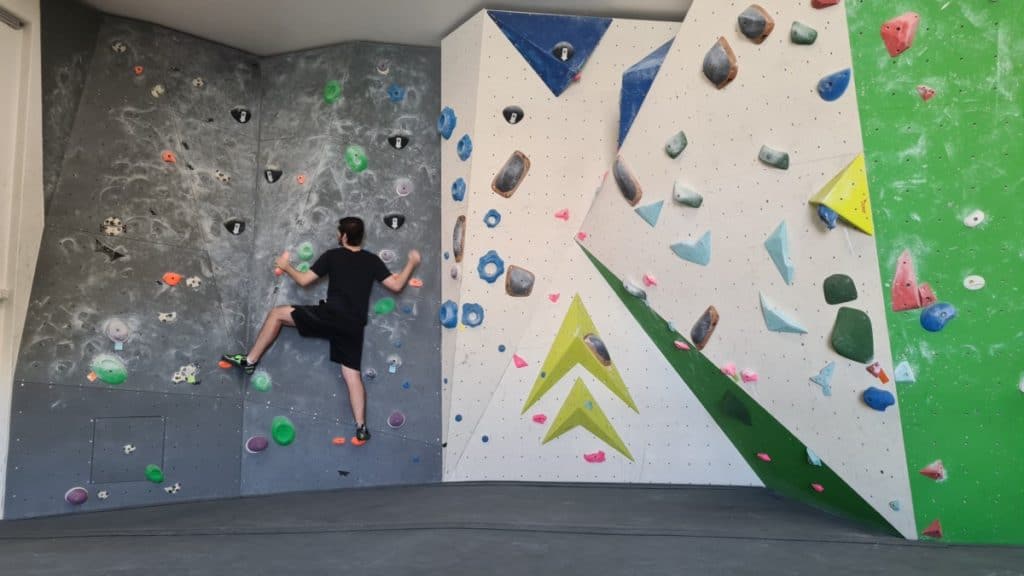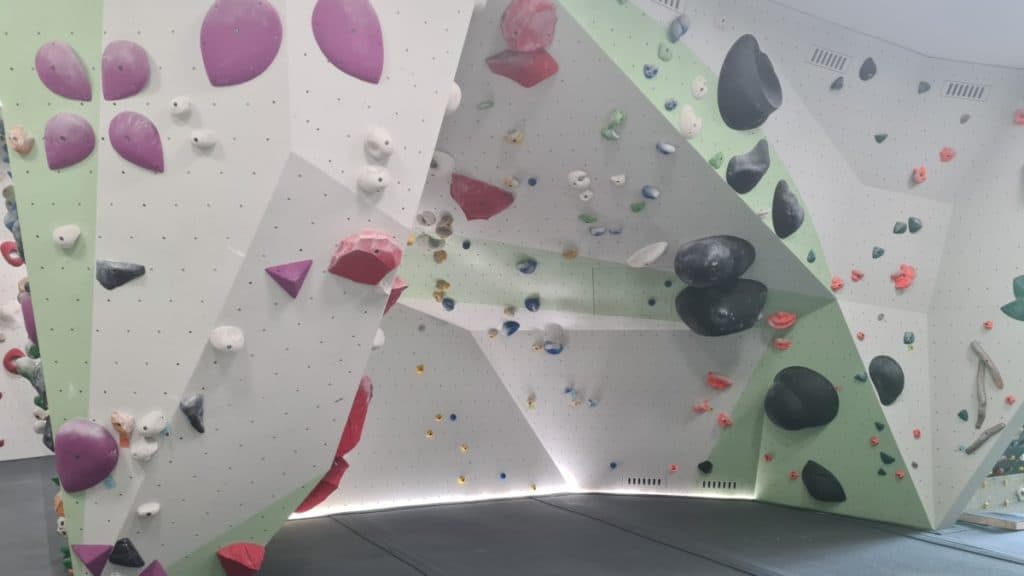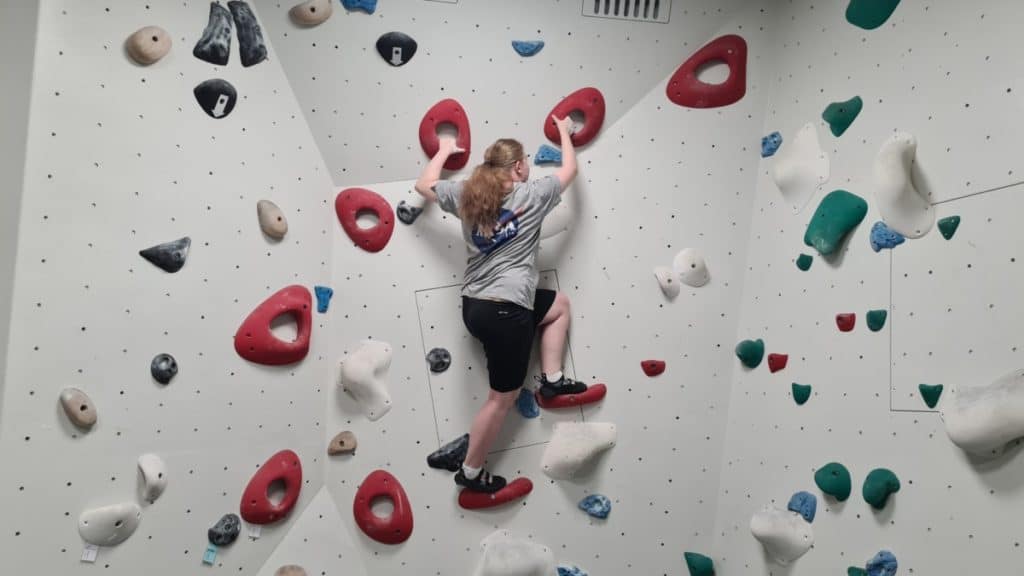
As a beginner I always saw people training on those cool hangboards and I wondered if this is necessary to improve my climbing strength. After years of climbing experience I learned much about what it really needs to develop general climbing strength and what can be useful along the way of getting a better climber.
In general, you can either improve your climbing strength directly on the wall with climbing physically exhausting routes, which is especially recommended for beginners. Or as you get better, you can also use additional training devices, like a hangboard to train on more specific strengthes.
To learn how you improve your climbing strength as a beginner, intermediate or advanced climber and what body parts you need to train, keep reading. I will also go into detail how you can train your climbing strength at home or directly on the wall.
What Body Parts Does Climbing Strengthen?
To improve your climbing strength you first need to know which body parts climbing involves and you have to train on. To ask the answer differntly you could also ask what body parts climbing strengthens, because the sport itself is already a great training for climbing strength improvement.
Because climbing is a full-body training, it strengthens every muscle in your body. However your back and arm musculature is way more involved than your lower body muscles. Especially the fingers are also strengthend by climbing, which is very unique to this sport.
In easier routes the holds are very big and easy to grab, so your arms are doing the main work, when you are pulling yourself up to the next hold. When the routes get harder the holds also get smaller and more finger strength is needed to climb on them.
Climbing strengthens the whole body, especially the back, arms and fingers.
The lower body is heavily involved, when it comes to overhangs. Because you can’t stand on your feet anymore you need to press them against the holds, which needs a lot of leg and core strength. The forearms also get strengthend from overhangs, because you are hanging on the holds now and and grabbing them requires a lot of power.
When you are climbing overhangs the first time you will know what I mean, as your forearms get very hard and pumped, because you body is very unused to this kind of climbing. However with time and practice your forearm strength will increase and they wont get as pumped anymore.

Improving Climbing Strength for Beginners
As a beginner just climbing on the wall improves your climbing strength a lot, because you didn’t develop any yet. So it’s very easy for you to improve for your climbing strength and in the beginning you can see progress almost from session to session.
From just climbing normally you will build general climbing strength over time that includes your entire body. Especially your arm and finger strength will improve a lot over the first couple months of climbing. Building general climbing strength will allow you to improve your climbing and attempt harder routes.
In the beginning I recommend you try every route that looks interesting to you, also the ones your are not able to climb yet. Your body doesn’t care if you can climb all the way up to the top or not. Your climbing strength will also increase if you only climb the route half the way twice.
When climbing different kind of routes in the beginning, you will also learn a lot about techique and how to approach different elements of holds. There are technical routes that don’t require much power, routes that are made out of a lot of smaller holds and are heavy on the finger strength and physical routes that require a lot of power in general.
When I started climbing back in 2018 the ones that required a lot of finger strength where the hardest to me, because I really lacked grip strength. This is totally normal for beginners in climbing, because in our every day lives or other sports you don’t need strong fingers and don’t use them as much as other muscles.
Because the fingers are so underdevolped for climbing compared to other muscles like the arms, most easy routes have bigger holds (jugs) where you don’t need your fingers that much. However you should still try to sometimes climb harder routes where your fingers are more involved to develop a good grip strength.
Training your fingers on hangboard or other devices is completely unnecessary in the bginning, because you still progress so fast from just climbing. It can even be harmful to apply so much pressure on your fingers as a beginner, because your joints and tendons need way longer than your muscles to adapt to climbing and you could injure yourself by doing so.
As a beginner it is totally okay to just climb once or twice a week, because over time you will develop general climbing strength from just climbing on the wall. However you sould always try to include some routes that are on your limit in each climbing session to maximize your progress.
If you do additional basic strength training at home or in the gym as a beginner climber thats completely fine, as it will just support your climbing strength. However you should really be careful to rest enough and give your body the time to recover. If you want to know how long you should rest between climbing sessions click here.

Improving Climbing Strength for Intermediate
As you get a better climber you fully developed general climbing strength and it is time to train a bit more specific. A great way of involving other body parts for your climbing you usually don’t use, are overhangs. Overhangs are routes on a wall that is very steep and you can’t stand on the holds anymore.
This kind of climbing adds forearm, core and leg strength in your climbing training. Because you can’t stand on the feet holds anymore, you are forced to apply much pressure on them with your legs in order to climb the route. You also need to grab the holds very hard which strengthens your forearms.
You should try to atleast involve one overhang route in every climbing seesion when you are at a intermadiate level of climbing, because it is very different to all the other routes on straight walls. Overhangs are physically very hard and exhausting, which builds up climbing stength really fast.
When you get better at climbing you can also start to use additional advices like a hangboards, to train specific climbing strength. You could also use training walls like the moonboard, where you can choose specific routes that target your weaknesses.
However in the end the additional training is pretty wasted if it isn’t fun for you. As a hobby climber you should enjoy the sport and improvement isn’t everything. You will still improve your climbing strength from just climbing, it will just take a bit longer.
You could also get started to use additional devices like a hangboard or training walls like moonboards if you want to, so you can train specifically on weaknesses. However if this additional training isn’t fun, you don’t have to do it, as you will stll improve your climbing strength from only climbing on the wall.
Improving Climbing Strength for Advanced
As an advanced climber you already built up very good climbing strength that exceeds the genral climbing strength and includes your whole body. Because of this you can’t really improve anymore from normal climbing on the wall and you have to do additional training, if you still want to increase your climbing strength.
So you will want to use hangboards, like the beastmaker (image below) which is the most popular one, to improve the strength in specific areas of your body. On the hangboard you can build up way more grip strength than you would solely from climbing routes.
However you should still keep climbing to remain your strength and also try very hard routes you can’t climb yet, to improve in the grades. It might wont improve your climbing strength that much, but it makes you a better climber in general when you always try new and harder routes and eventually climb them.
If you are an advanced climber, but it is still a hobby for you, improving your climbing strength isn’t everything. When fun is the most important factor, just keep doing the things you enjoy and let other people climb on the hangboards and training walls.
How You Can Improve Your Climbing Strength at Home
Training at home for specific climbing strength is only recommended for intermediate to advanced climber, because this is benefitial for them. Beginners still get the most value from just climbing on the wall and additional strength training isn’t necessary.
General weight training will already improve your climbing strength, because climbing is a full-body sport and stronger arms and legs support your climbing performance. However there are also specific areas of your body that are not included in normal weight training, like your forearms and hands, but are essential for climbing.
You can also train those body parts at home with exercises like holding thick books in your hands. Just google “exercises at home for climbers” and you will find many great examples how you can train your body for climbing and improve your strength.
Sometimes it can also be benfitial to buy equipment for your home work out. This could be things like dumbbells or a hangboard. If it is worth to buy equipment, depends on how much money you are willing to spend and which weaknesses you want to work on. If finger strength is a problem for you, go buy a hangboard if you can afford it.
How You Can Improve Your Climbing Strength on The Wall
As a beginner it really doesn’t matter which routes you climb, because every route will improve your climbing strength. But as you get better, you want to structure your climbing sessions and climb different kind of routes, so you improve in every single aspect of climbing.
You want to climb different routes to focus on grip strength than you are climbing for improving your technique and coordination. You also want to include hard and physically exhauting routes that are at the edge of your abilities to improve your general climbing strength.
If you want to learn more about how you structure your climbing sesson click here. I wrote a entire article about how you optimally structure your training and progress in climbing.
Final Thoughts
Climbing strength is a key factor of getting better as a climber and because of that you should always try to improve it. There are so many different ways to do it, so try to pick the way you think works best for you and is the most enjoyable to you. I recommended that, because when you can’t enjoy the process you are very likely to quit.
However climbing strength is not everything and you should also focus on other aspect of climbing, such as your climbing techique and endurance. They are big parts of becoming a good climber, so you should definitely try to improve them aswell.

